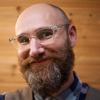In 1629 and 1630, Maximus of Gallipoli sat in a room in the Dutch embassy in Constantinople (today, Istanbul). A learned monk ordained as a priest in the Greek Orthodox Church, he spent his days in the ambassador’s residence overlooking the Golden Horn on the Bosporus Strait, laboring on the first ever translation of the New Testament into the Greek vernacular. Maximus’s text, published only in 1638, is little known outside a handful of academic specialists. This is unfortunate because his achievement in rendering ancient, first-century Greek into modern, intentionally simple, seventeenth-century Greek was remarkable. The circumstances surrounding the text are, moreover, the stuff of an Orhan Pamuk novel, filled with international intrigue: Created in the heart of the Ottoman Empire, aided by Reformed Swiss-Italians, corrected by the Patriarch of the Orthodox Church of Constantinople, coordinated by the Dutch ambassador, paid for by the Dutch Republic, and printed in Geneva under the oversight of the Venerable Company of Pastors, Maximus’s edition demonstrates how the European reformations touched but did not take hold of the Greek Orthodox world.
Maximus’s translation belongs, properly, to the turbulent age of Cyril Lucaris, whose tenure as patriarch of Constantinople ran from 1620, with several interruptions, until 1638. Born in Crete (then under Venetian rule), Lucaris spent time in Padua and Venice studying under Greek humanists with ecumenical sympathies. Some historians allege that he visited the Low Countries and even Geneva, where he was introduced directly to Reformed theology, but there is no evidence to place him in either location. Upon ordination, Lucaris went to Brest in Poland-Lithuania as a special envoy of the then patriarch of Alexandria, his uncle, to help the Orthodox curb Roman Catholic intrusions into Poland, an operation that mostly failed. In 1601, Lucaris found himself installed as patriarch of Alexandria in Cairo, Egypt, where he remained until 1620 when he became patriarch of Constantinople, again battling Roman Catholic interference among Orthodox Christians.
Lucaris loved to exchange ideas with European Protestants. Exactly what sparked his interest is unknown, but in 1602 he met the Dutchman Cornelius Haga, then traveling in Istanbul. When in 1612, Sultan Ahmed permitted the Dutch to trade in the Ottoman Empire, Haga became the Dutch Republic’s first diplomatic representative to the Sublime Porte. Through Haga, Lucaris began to correspond with various Dutch Protestant ministers. He bought and annotated books by both Protestant and Roman Catholic authors: Jacobus Arminius, Robert Bellarmine, and others. He discussed Christianity with the archbishop of Canterbury and with Marco Antonio de Dominis, the erstwhile archbishop of Spalato (today, Split, Croatia), who fled to England after a disagreement with Rome. He gifted the priceless Codex Alexandrinus, one of the earliest and most complete manuscripts of the Bible, to King James I of England for James’s support in Lucaris’s struggle to retain the patriarchate against his enemies, who had been aligning themselves with Jesuits to steer the Orthodox toward Tridentine Catholicism. As the gift to England shows, he reached out to Protestants abroad while engaged in battle with Roman Catholics at home.
Repeated confrontations with the Jesuits characterize Lucaris’s time in Constantinople. One scholar estimates that different Roman Catholic and Protestant groups paid a combined 54 million akçe—nearly what it cost to build Istanbul’s grand Süleymaniye Mosque in the 1550s—in bribes to Ottoman authorities to have Lucaris either deposed or reinstated. Jesuits set up free schools for Greek Orthodox children that focused on the Latin rite. The Congregation for the Propagation of the Faith in Rome set its polyglot press buzzing, churning out Greek books celebrating Roman Catholicism and delivering them to Jesuit missionaries around the eastern Mediterranean. In response, Lucaris established the first, albeit short-lived, Greek printing press in the East. The texts that issued from it included a vernacular Greek statement of the Orthodox faith and Latin and Greek versions of Lucaris’s own Confession of Faith, a document clearly affirming the supreme authority of Scripture for faith and life, justification by faith alone, and predestination. Financed by the Dutch Republic and printed in Geneva—all arranged by Cornelius Haga—the Confession has since earned Lucaris the sobriquet, in some circles, of the “Protestant Patriarch.” While Lucaris’s full desire to see the Reformed tradition embraced among the Orthodox is debatable, he did encourage the Dutch to send two hundred copies of the Belgic Confession and Heidelberg Catechism, which had been translated into Greek and printed under the title Ecclesiarum Belgicarum confessio, now bound with select canons from the Synod of Dort, making special efforts to distribute them in Constantinople.
Lucaris’s groundbreaking project—again with the Dutch—was the modern Greek Bible. One of the main figures responsible for it was Antoine Léger, a minister from Piedmont and close friend of Benedict Turretin, himself a pastor-professor in Geneva and father of the more well-known theologian Francis Turretin. Sent from Geneva’s Company of Pastors, Léger served as chaplain to Cornelius Haga, the Dutch ambassador in Constantinople. Léger assisted Maximus the translator, while Lucaris helped proofread and revise the text. The source text they used was an Italian translation made in 1607 by Giovanni Diodati, the Swiss-Italian theologian and linguist. The Dutch ambassador wanted the text printed in two columns with ancient Greek on the left and vernacular on the right “in order to deprive the Papists of any means” to critique the translation. “You have done well,” Lucaris told Léger, “to collate the original texts with the vernacular. I see that Father Maximus has been very diligent in his translation. The text of Mr Diodati has been followed. Doubt about certain words matter little, while all [words] correspond to their meaning.” Lucaris did challenge Maximus’s choice for the right Greek word for “bread,” suggesting the more common psomi, rather than artos and explaining his rationale in great detail.
The States General, de facto federal government of the Dutch Republic, agreed to cover the costs for printing the translation. They asked Jacob Golius, professor of Arabic at the Calvinist University of Leiden, to determine whether the translation would incite any riots among Greeks—apparently, Golius said no. Cornelius Haga insisted on the production of no fewer than 1,500 copies. More than 150 were to be kept by Haga and the University of Leiden; the rest of the books were to be shipped secretly to Constantinople for distribution. Maximus was also to go to Geneva to oversee the proofreading and typesetting. The project’s final phases, however, turned out to be far more complicated than expected. Both Maximus’s travel expenses and the paper for the books ran far over budget and required new sources of funding. The printer’s copy of the text was initially lost and when found was basically illegible because of the shorthand and abbreviations used. Léger’s successor died before he could complete revisions, and Maximus died before the transcription and typesetting were completed. David Le Clerc, Geneva’s professor of oriental languages, was hired to proofread, but he too died before the work was finished.
By the time the translation reached print, Lucaris had also died. Following an accusation by Jesuits in Constantinople, who alleged that Lucaris planned a rebellion against the Ottomans, Lucaris was arrested and convicted of high treason. He was strangled by Janissaries, the elite infantry units that formed the Ottoman Sultan’s army, and his body was thrown from a ship into the Bosporus. Without the original team—Maximus, Lucaris, Cornelius Haga, Léger—the translation’s distribution was a total fiasco. Some copies went to Leiden as agreed. Four hundred copies went to Haga’s house back in the Netherlands. The remainder were to be carted from Geneva to Marseille and then shipped to Constantinople, but most of these never left Geneva. Instead, they were confiscated by the printing house because the rent for the room in which the books had been stored had gone unpaid. Nearly thirty years later, Genevan theologian Francis Turretin informed Dutch Levantine Trade directors that 1,130 copies of these New Testaments were still in storage in Geneva. Still later, Turretin’s son, Jean-Alphonse, reminded the States General that he had the books in his possession, ready for shipment. Not until the 1730s—some hundred years after the project began—did the books finally travel east.
In the end, what makes Lucaris most luminous is his consistent championing of the Bible in terms evocative of Protestants—from Luther and eventually, though after Lucaris’s time, to the Westminster Divines. In the appendix to his Confession, Lucaris said that the Holy Spirit worked through the word to dispel darkness. No one, therefore, should prevent any person from reading the Bible and finding in it the doctrines of the Christian faith. In the preface he wrote to the 1638 New Testament, he stressed that readers should be able to access the text directly and not only as mediated by elite clerics, as in traditional Orthodox practice. All Christians, and all of his people, Lucaris insisted, should be able to read Scripture in their own language. The goal was as admirable as it was dangerous, for it pitted him against many of his Orthodox peers and certainly shortened his life—just as many Reformers met persecution when they embraced sola scriptura. Cyril Kontaris, Lucaris’s successor as patriarch of Constantinople, had been educated at the Jesuit College in Istanbul and harbored sympathies for Rome. He swiftly convoked a synod to have Lucaris and his publications anathematized. Finally, in 1672, the Orthodox Synod of Jerusalem condemned the New Testament in vernacular Greek. In this sense, at least, the European reformations did not pass the Greek Orthodox world by.
Footnotes
Ovidiu Olar, “‘Un Trésor enfoui’: Kyrillos Loukaris et le Nouveau Testament en grec publié à Genève en 1638 à travers les lettres d’Antoine Léger,” Cahiers du Monde russe 58, no. 3 (2017): 341–70.
BackOvidiu Olar, “La boutique de Théophile: les relations du patriarche de Constantinople Kyrillos Loukaris (1570–1638) avec la réforme” (Paris: EHESS; Centre d’études byzantines, néo-helléniques et sud-est européennes, 2019).
BackDénes Harai, “Une Chaire aux enchères: ambassadeurs catholiques et protestants à la conquête du patriarcat grec de Constantinople, 1620–1638’, Revue d’histoire moderne et contemporaine 58, no. 2 (2011): 49–71.
BackZacharias N. Tsirpanlis, “Libri greci pubblicati dalla ‘Sacra Congregatio de Propaganda Fide’ (XVII sec.),” Balkan Studies 15 (1974): 204–24.
BackEvro Layton, “Nikodemos Metaxas, the First Greek Printer in the Eastern World,” Harvard Library Bulletin 15, no. 2 (1967): 140–68.
BackSee, e.g., Steven Runciman, The Great Church in Captivity (Cambridge: Cambridge University Press, 1968), 259–88; and George A. Hadjiantoniou, Protestant Patriarch: The Life of Cyril Lucaris (1572–1683) (Richmond, VA: John Knox Press, 1961).
BackVasileios Tsakiris, “The ‘Ecclesiarum Belgicarum Confessio’ and the Attempted ‘Calvinisation’ of the Orthodox Church under Patriarch Cyril Loukaris,” Journal of Ecclesiastical History 63, no. 3 (2012): 475–87.
BackChristiaan Sepp, “Het Nieuw-Grieksche Testament van 1638,” Bibliografische mededeelingen (Leiden: E. J. Bril, 1883), 203.
BackÉmile Legrand, Bibliographie hellénique, vol. 4 (Paris: Leroux, 1896), 476, in Richard Calis, “The Impossible Reformation: Protestant Europe and the Greek Orthodox Church,” Past & Present 259 (May 2023): 43–76, at 65.
BackSepp, “Het Nieuw-Grieksche Testament van 1638,” 187–256.
BackΗ Καινή Διαθήκη του Κυρίου ἡμών Ιησού Χριστού: Δίγλωττος, ̓Εν ἧ ἀντιπροσώπως τό τε θείον πρωτότυπον καὶ ἡ ἀπαραλλάκτως ἐξ ἐκείνου εἰς ἁπλὴν διάλεκτον, διά τοῦ μακαρίτου κυρίου Μαξίμου του Καλλιουπολίτου γενομένη μετάφρασις ἅμα ἐτυπώθησαν (Geneva, 1638), **3v–***2v.
BackAnthony J. Khokar, “The ‘Calvinist Patriarch’ Cyril Lucaris and His Bible Translations,” Scriptura 114 (2015): 1–15.
Back







